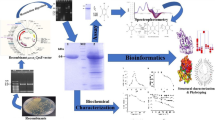Abstract
Comamonas strain CNB-1 was isolated from a biological reactor treating wastewater from a p-chloronitrobenzene production factory. Strain CNB-1 used p-chloronitrobenzene as sole source of carbon, nitrogen, and energy. A 2-aminophenol 1,6-dioxygenase was purified from cells of strain CNB-1. The purified 2-aminophenol 1,6-dioxygenase had a native molecular mass of 130 kDa and was composed of α- and β-subunits of 33 and 38 kDa, respectively. This enzyme is different from currently known 2-aminophenol 1,6-dioxygenases in that it: (a) has a higher affinity for 2-amino-5-chlorophenol (Km=0.77 μM) than for 2-aminophenol (Km=0.89 μM) and (b) utilized protocatechuate as a substrate. These results suggested that 2-amino-5-chlorophenol, an intermediate during p-chloronitrobenzene degradation, is the natural substrate for this enzyme. N-terminal amino acids of the α- and β-subunits were determined to be T-V-V-S-A-F-L-V and M-Q-G-E-I-I-A-E, respectively. A cosmid library was constructed from the total DNA of strain CNB-1 and three clones (BG-1, BG-2, and CG-13) with 2-aminophenol 1,6-dioxygenase activities were obtained. DNA sequencing of clone BG-2 revealed a 15-kb fragment that contained two ORFs, ORF9 and ORF10, with N-terminal amino acid sequences identical to those of the β- and α-subunits, respectively, from the purified 2-aminophenol 1,6-dioxygenase. The enzyme was actively synthesized when the genes coding for the ORF9 and ORF10 were cloned into Escherichia coli.




Similar content being viewed by others
References
Bradford MM (1976) A rapid and sensitive method for the quantification of microgram quantities of protein utilizing the principle of protein-dye binding. Anal Biochem 72:248–254
Davis JK, He Z, Somerville CC, Spain JC (1999) Genetic and biochemical comparison of 2-aminophenol 1,6-dioxygenase of Pseudomonas pseudoalcaligenes JS45 to meta-cleaveage dioxygenases: divergent evolution of 2-aminophenol meta-cleavage pathway. Arch Microbiol 172:330–339
Davison AD, Karuso P, Jardine DR, Veal DA (1996) Halopicolinic acids, novel products arising through the degradation of chloro-and bromobiphenyl by Sphingomonas paucimobilis BPSI-3. Can J Microbiol 42:66–71
European Economic Community (1982) Communication from the commission to the council on dangerous substances which might be included in list I of council directive 76/464/EEC. European Economic Community, Brussels
Häggblom MM (1992) Microbial breakdown of halogenated aromatic pesticides and related compounds. FEMS Microbiol Rev 103:29–72
Iwagami SG, Yang K, Davies J (2000) Characterization of the protocatechuic acid catabolic gene cluster from Streptomyces sp. strain 2065. Appl Environ Microbiol 66:1499–1508
Johnson GR, Spain JC (2003) Evolution of catabolic pathways for synthetic compounds: bacterial pathways for degradation of 2,4-dinitrotolunene and nitrobenzene. Appl Microbiol Biotechnol 62:110–123
Katsivela E, Wray V, Pieper DH, Wittich R-M (1999) Initial reactions in the biodegradation of 1-chloro-4-nitrobenzene by a newly isolated bacterium, strain LW1. Appl Environ Microbiol 65:1405–1412
Konopka A (1993) Isolation and characterization of subsurface bacterium that degrades aniline and methylanilines. FEMS Microbiol Lett 111:93–100
Lendenmann U, Spain JC (1996) 2-aminophenol 1,6-dioxygenase: a novel aromatic ring cleavage enzyme purified from Pseudomonas pseudoalcaligenes JS45. J Bacteriol 178:6227–6232
Linch AL (1974) Biological monitoring for industrial exposure to cyanogenic aromatic nitro and amino compounds. Am Ind Hyg Assoc J 62:784–790
Livingston AG, Brookes PR (1994) Biological detoxification of a 3-chloronitrobenzene manufacture wastwater in an extractive membrane bioreactor. Water Res 28:1347–1354
Park H-S, Kim H-S (2000) Identification and characterization of the nitrobenzene catabolic plasmids pNB1 and pNB2 in Pseudomonas putida HS12. J Bacteriol 182:573–580
Park H-S, Lim S-J, Chang YK, Livingston AG, Kim H-S (1999) Degradation of chloronitrobenzenes by a coculture of Pseudomonas putida and a Rhodococcus sp. Appl Envrion Microbiol 65:1083–1091
Sala-Trepat JM, Evans WC (1971) The meta-cleavage of catechol by Azobacter species. Eur J Chem 20:400–413
Sambrook J, Russell DW (2001) In: Molecular Cloning, 3rd edn, vol 1. CSHL Press, Cold Spring Harbor, New York, pp 4.11–4.24
Shimizu M, Yasui T, Matsumoto N (1983) Structural specificity of aromatic compounds with special reference to mutagenic activity in Salmonella typhimurium-a series of chloro- or fluoro-nitrobenzene derivatives. Mutat Res 116:217–238
Spence EL, Kawamukai M, Sanvoisin J, Braven H, Bugg TDH (1996) Catechol dioxygenases from Escherichia coli (MphB) ad Alcaligenes eutrophus (MpcI): sequence analysis and biochemical properties of a third family of extradiol dioxygenases. J Bacteriol 178:5249–5256
Sugimoto K, Senda T, Aoshima H, Masai E, Fukuda M, Mitsui Y (1999) Crystal structure of an aromatic ring opening dioxygenase LigAB, a protocatechuate 4,5-dioxygenase, under aerobic conditions. Structure 7:953–965
Takenaka S, Murakami S, Shinke R, Hatakeyama K, Yukawa H, Aoki K (1997) Novel genes encoding 2-aminophenol 1,6-dioxygenase from Pseudomonas species AP-3 growing on 2-aminopheol and catalytic properties of the purified enzyme. J Biol Chem 272:14727–14732
Takenaka S, Murakami S, Kim Y-J, Aoki K (2000) Complete nucleotide sequence and functional analysis of the genes for 2-aminophenol metabolism from Pseudomonas sp. AP-3. Arch Microbiol 174:265–272
Weisburger EK, Russfield F, Homburger F, Weisburger JH, Boger E, Van Dongen CG, Chu KC (1978) Testing of twenty-one environmental aromatic amines or derivatives for long-term toxicity or carcinogenicity. Environ Pathol Toxicol 2:325–356
Acknowledgements
This work was supported by grants (NSFC30230010 and KSCX2-SW-113) from Chinese Academy of Sciences and National Natural Science Foundation of China. We are grateful to Harold L. Drake at the University of Bayreuth, Germany, for his assistance during the revision of this paper.
Author information
Authors and Affiliations
Corresponding author
Rights and permissions
About this article
Cite this article
Wu, JF., Sun, CW., Jiang, CY. et al. A novel 2-aminophenol 1,6-dioxygenase involved in the degradation of p-chloronitrobenzene by Comamonas strain CNB-1: purification, properties, genetic cloning and expression in Escherichia coli. Arch Microbiol 183, 1–8 (2005). https://doi.org/10.1007/s00203-004-0738-5
Received:
Revised:
Accepted:
Published:
Issue Date:
DOI: https://doi.org/10.1007/s00203-004-0738-5




